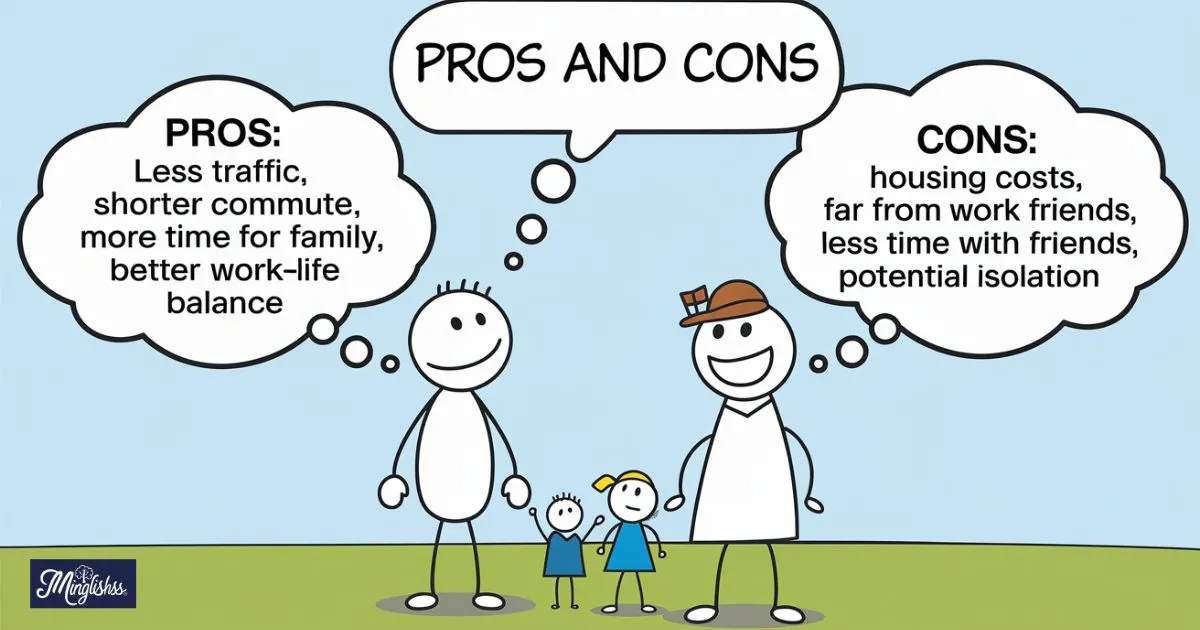“Different ways to express the balance of advantages and disadvantages enriches our communication.“
When making decisions, we often find ourselves weighing the pros and cons. This familiar phrase helps us evaluate the advantages and disadvantages of various choices, guiding us toward informed conclusions. However, using the same phrase repeatedly can make discussions monotonous. By incorporating alternative expressions, we can keep our conversations lively and engaging while conveying the same essential meaning.
If you want to enhance your communication skills and make your discussions more impactful, this blog is for you. Exploring other ways to say “pros and cons” will empower you to articulate your thoughts more effectively. By varying your expressions, you can not only enrich your conversations but also better connect with your audience.
In this blog, we will delve into 35 alternative phrases for “pros and cons,” complete with scenarios and subject explanations. Whether you’re discussing business strategies, personal choices, or everyday dilemmas, these expressions will help you communicate your thoughts more clearly and effectively.
1. “Advantages and Disadvantages”
Scenario
When evaluating a new project proposal at work.
Subject Explanation
This classic phrase explicitly outlines the positive and negative aspects of a situation. By clearly identifying what is favorable and what is not, you provide a straightforward assessment that everyone can understand.
Additional Tips
Use bullet points when presenting these advantages and disadvantages to enhance clarity. Visual aids can help reinforce the discussion.
2. “Benefits and Drawbacks”

Scenario
When discussing the potential impact of a new software tool.
Subject Explanation
This expression emphasizes what can be gained versus what may be lost. It invites a balanced view of the situation and encourages stakeholders to consider both sides before making a decision.
Additional Tips
Provide examples to illustrate both benefits and drawbacks effectively. Real-life scenarios can help ground your points.
3. “Strengths and Weaknesses”
Scenario
When conducting a SWOT analysis for a product launch.
Subject Explanation
This phrase focuses on the internal characteristics of the subject. By highlighting strengths and weaknesses, you can assess the viability of a project or product more accurately.
Additional Tips
Create a detailed SWOT analysis to visualize how strengths and weaknesses interplay with opportunities and threats.
4. “Gains and Losses”
Scenario
When analyzing the financial aspects of a new investment.
Subject Explanation
This phrase directly addresses the potential profit and risks involved in a decision. It’s particularly useful in financial discussions, where clarity about potential gains and losses is critical.
Additional Tips
Use numerical data to quantify gains and losses for better clarity. Presenting statistics can make your argument more compelling.
5. “Positive and Negative Aspects”
Scenario
When discussing a potential career move with a friend.
Subject Explanation
This expression emphasizes both sides of the argument. It allows for an open discussion about what could be beneficial and what might pose challenges.
Additional Tips
Encourage your friend to share their thoughts on each aspect to foster understanding and mutual decision-making.
6. “Favorable and Unfavorable Points”
Scenario
When reviewing a job offer with your partner.
Subject Explanation
This expression clearly outlines what is appealing and what is concerning about a particular option. By categorizing points this way, you can facilitate a more organized discussion.
Additional Tips
Make a checklist of favorable and unfavorable points to aid your decision-making process.
7. “Plus and Minus”

Scenario
During a casual discussion about holiday plans.
Subject Explanation
This informal phrase simplifies the evaluation process. It works well in relaxed settings where a straightforward comparison is all that’s needed.
Additional Tips
Use this expression in quick meetings to keep discussions efficient and focused.
8. “Opportunities and Risks”
Scenario
When considering a new business venture with colleagues.
Subject Explanation
This phrase focuses on potential success versus possible pitfalls, emphasizing the dual nature of every opportunity.
Additional Tips
Conduct a risk assessment to better understand the opportunities and risks involved. This can aid in making informed decisions.
9. “Merits and Demerits”
Scenario
When analyzing a public policy proposal.
Subject Explanation
This expression discusses what is commendable versus what is objectionable, often used in political and ethical discussions.
Additional Tips
Provide context for each merit and demerit to enhance understanding and engagement.
10. “Positives and Negatives”
Scenario
When debating the merits of a new environmental initiative.
Subject Explanation
This phrase offers a balanced perspective, ensuring that both favorable and unfavorable elements are considered.
Additional Tips
Encourage participants to share their personal experiences related to each positive and negative aspect.
11. “Rewards and Consequences”
Scenario
When making a significant life decision, such as moving to a new city.
Subject Explanation
This expression emphasizes potential outcomes of choices, helping individuals to reflect on what they stand to gain and what they might lose.
Additional Tips
Discuss hypothetical scenarios to visualize the rewards and consequences clearly.
12. “Pros and Pitfalls”
Scenario
When implementing a new company policy.
Subject Explanation
This phrase highlights the benefits while acknowledging potential challenges, allowing for a thorough examination of the proposal.
Additional Tips
Share user testimonials to illustrate both pros and pitfalls, providing real-life context to your discussion.
13. “Assets and Liabilities”
Scenario
When evaluating a business plan’s financial viability.
Subject Explanation
This expression assesses what can be leveraged against what can be burdensome, particularly in financial discussions.
Additional Tips
Use financial metrics to quantify assets and liabilities for clarity in your analysis.
14. “Virtues and Flaws”
Scenario
When discussing personal development with a friend.
Subject Explanation
This phrase explores positive traits alongside shortcomings, emphasizing self-awareness in personal growth.
Additional Tips
Encourage self-reflection on personal virtues and flaws to foster deeper understanding and improvement.
Other Ways to Say “Thank You for Your Thoughtfulness”
15. “Features and Drawbacks”
Scenario
When reviewing the specifications of a new gadget.
Subject Explanation
This expression highlights specific characteristics and limitations, allowing consumers to make informed choices.
Additional Tips
Create a comparison chart to visualize features and drawbacks effectively, enhancing your presentation.
16. “Upsides and Downsides”

Scenario
During a discussion about vacation destinations.
Subject Explanation
This informal phrase succinctly conveys the good and the bad, making it easy for friends to consider their options.
Additional Tips
Share personal anecdotes related to upsides and downsides for relatability and engagement.
17. “Highlights and Low Points”
Scenario
When recapping a recent event or experience.
Subject Explanation
This expression summarizes the best and worst moments, offering a well-rounded perspective.
Additional Tips
Encourage attendees to share their own highlights and low points for comprehensive feedback and discussion.
18. “For and Against”
Scenario
When debating a contentious issue, like climate change policies.
Subject Explanation
This phrase highlights opposing arguments in discussions, providing a balanced view of differing perspectives.
Additional Tips
Encourage respectful dialogue by allowing each side to present their points and counterpoints.
19. “Pros and Cons List”
Scenario
When making a personal decision, such as whether to take a new job.
Subject Explanation
This straightforward expression allows for visual comparison, helping individuals organize their thoughts.
Additional Tips
Create a visual diagram or spreadsheet to facilitate discussion and enhance decision-making.
20. “Reasons to Support and Oppose”
Scenario
When analyzing a political policy.
Subject Explanation
This phrase clearly distinguishes supporting and opposing arguments, providing a structured view of the debate.
Additional Tips
Use factual data to support each reason for better understanding and credibility.
21. “Wins and Losses”
Scenario
When discussing a sports team’s season performance.
Subject Explanation
This expression highlights the successes and failures experienced throughout the season.
Additional Tips
Share statistics and game highlights to substantiate your points on wins and losses.
22. “Successes and Failures”
Scenario
When evaluating a marketing campaign.
Subject Explanation
This phrase emphasizes the outcomes of actions taken, allowing for a retrospective assessment of effectiveness.
Additional Tips
Analyze metrics from the campaign to illustrate successes and failures clearly.
23. “Points For Consideration”
Scenario
When brainstorming ideas for a new project.
Subject Explanation
This phrase invites others to think critically about various factors that may influence decision-making.
Additional Tips
Create a collaborative environment where all team members can contribute their points for consideration.
24. “Factors in Favor and Against”
Scenario
When discussing potential changes to workplace policies.
Subject Explanation
This expression outlines the various elements that support or oppose a decision.
Additional Tips
Encourage team discussions to explore different factors comprehensively.
25. “Benefits and Costs”
Scenario
When evaluating a subscription service.
Subject Explanation
This phrase focuses on what can be gained versus what must be paid, ensuring an informed choice.
Additional Tips
Provide clear pricing information alongside potential benefits to facilitate understanding.
26. “Shortcomings and Advantages”
Scenario
When analyzing a competitor’s product.
Subject Explanation
This expression examines what is lacking compared to what is offered, providing a balanced view of the comparison.
Additional Tips
Encourage discussions about how to address shortcomings while emphasizing advantages.
27. “Positives and Negatives”
Scenario
When reviewing a friend’s choice of college.
Subject Explanation
This phrase allows for an easy understanding of the good and the bad aspects of the decision.
Additional Tips
Share personal experiences related to positives and negatives to enrich the conversation.
28. “Pros and Cons Analysis”
Scenario
When discussing different modes of transportation for a trip.
Subject Explanation
This phrase invites a thorough examination of the benefits and challenges associated with each option.
Additional Tips
Consider using a group chat to gather input from multiple perspectives during the analysis.
29. “Good Points and Bad Points”
Scenario
When debating a new restaurant to try with friends.
Subject Explanation
This expression offers a straightforward way to articulate what is appealing and what is not about a choice.
Additional Tips
Encourage everyone to contribute their good and bad points for a more robust discussion.
30. “Favorable Outcomes and Adverse Effects”
Scenario
When discussing health benefits of a new diet.
Subject Explanation
This phrase highlights the positive results while recognizing possible negative impacts, ensuring a comprehensive evaluation.
Additional Tips
Research credible sources to support claims about favorable outcomes and adverse effects.
31. “Benefits and Risks”
Scenario
When analyzing a financial investment.
Subject Explanation
This expression emphasizes what can be gained alongside what may pose challenges, particularly in financial discussions.
Additional Tips
Utilize charts or graphs to visualize benefits and risks clearly.
32. “Wins and Setbacks”
Scenario
When reviewing a team’s performance in a project.
Subject Explanation
This phrase captures successes while recognizing areas that need improvement, promoting a balanced perspective.
Additional Tips
Encourage team members to celebrate wins while addressing setbacks constructively.
33. “Good and Bad”

Scenario
During a light-hearted discussion about movie genres.
Subject Explanation
This informal expression makes it easy to quickly convey what is enjoyable and what is less favorable.
Additional Tips
Use humor to highlight the good and bad aspects for a more engaging conversation.
34. “Prospects and Challenges”
Scenario
When discussing a startup’s future.
Subject Explanation
This phrase focuses on potential successes alongside obstacles, promoting a comprehensive outlook.
Additional Tips
Encourage brainstorming sessions to address challenges while exploring prospects.
35. “Gains and Risks”
Scenario
When evaluating a new fitness program.
Subject Explanation
This expression focuses on what participants can achieve versus the risks involved, ensuring informed decision-making.
Additional Tips
Provide personal testimonials from participants to illustrate gains and risks effectively.
Pros and Cons
Pros
- Enhances communication skills.
- Promotes clarity in discussions.
- Engages audiences by varying expressions.
- Encourages critical thinking.
Cons
- Some phrases may feel too formal in casual conversations.
- Overuse of alternatives can lead to confusion.
- Misinterpretation of terms may occur in complex discussions.
Answers To Key Questions “Pros and Cons”
Q1: Why should I use different expressions for “pros and cons”?
Using varied expressions can make your communication more engaging and help clarify your points more effectively.
Q2: Are there situations where “pros and cons” is the best choice?
Yes, in casual conversations, “pros and cons” is widely understood and can be more relatable.
Q3: Can I create my own expressions for “pros and cons”?
Absolutely! Feel free to get creative with your expressions, as long as they effectively convey the message.
Q4: How can I remember these alternatives?
Practice using them in your daily conversations or writing to help reinforce your memory of the phrases.
Q5: What if I confuse different terms?
Don’t worry! It’s normal to mix up phrases sometimes. Just take your time to understand their meanings, and practice using them correctly.
Conclusion
Exploring different ways to say “pros and cons” enriches our communication and enhances our ability to make informed decisions. By incorporating a variety of expressions, you can keep conversations engaging and clear, helping others understand the complexities of any situation.
As you navigate discussions in your personal and professional life, consider the alternatives we’ve explored here to communicate your thoughts more effectively.

Hi, I’m Lauren Reynolds: I bring creativity to English lessons, mixing fun with learning. My goal is to inspire students to explore and enjoy the language.










